Rock tumbling is a beloved hobby that allows enthusiasts to transform rough, irregularly shaped rocks into smooth, polished gems. The magic behind this transformation lies in using the proper rock tumbling grit. There are several options when it comes to grit, but silicon carbide is widely considered the preferred material for rock tumbling.
The standard rock tumbling process utilizes three main grit sizes – 60/90 coarse grit, 150/220 medium grit, and 500 fine grit. Additionally, a polishing compound is used in the final stage. Some of the most highly recommended products for rock tumbling grit include Polly Plastics Rock Tumbler Media Kit, 60/90 coarse silicon carbide, 120/220 medium silicon carbide, 500 fine aluminum oxide, and tin oxide polishing compound. The specific sequence and grit types used will depend on the hardness and texture of the rocks being tumbled.
There are two primary types of grit used in rock tumbling – silicon carbide and aluminum oxide. Silicon carbide is an extremely hard, man-made abrasive that efficiently cuts through rock. It tends to fracture into fresh, sharp edges providing the abrasion needed for shaping rocks. Aluminum oxide also has high hardness, but it fractures into more rounded points. This makes it ideal for gently polishing rocks during the final stage. Using the proper combination and sequence of these two grit types is key to achieving beautifully polished stones.
With an understanding of the different grit materials and sizes available, enthusiasts can select the ideal tumbling media for their project. Proper grit selection and application requires some trial and error, but the resulting dazzling gems make it well worth the effort.
Best Products
Best Choice – Rock Tumbler Grit Kit and Ceramic Tumbling Filler Media | Polly Plastics
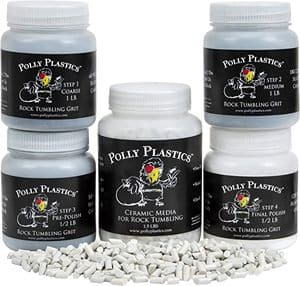
The Polly Plastics Rock Tumbler Grit Kit is the perfect way to start rock tumbling. This kit includes four different stages of grit and ceramic filler media so you can achieve a beautiful polish on your stones. The non-abrasive ceramic filler cylinders are compatible with all brands of tumblers and make it easy to keep your grit separated between steps. Plus, products come with a 100% satisfaction guarantee, so you can be sure you’re getting the best possible outcome.
I was so excited when I got this kit in the mail. I had wanted to get into rock tumbling for a while, and this kit seemed the perfect way to get started. It comes with everything you need to tumble several batches of stones, including the ceramic media, which is essential for keeping your rocks from damaging each other in the later tumbling.
I couldn’t wait to start, so I quickly read the instructions and got to work. I was delighted with how easy it was to get started, and I was amazed at how smooth and polished my rocks turned out after just a few rounds of tumbling.
I can’t wait to start experimenting with different types of rocks and see what kinds of beautiful finishes I can achieve. This kit has sparked my interest in rock tumbling, and I’m sure I’ll be doing it for years to come! All my friends are going to be so jealous when they see the beautiful jewelry I’m able to make with my newly polished rocks.
Pros:
- Comes with everything you need to get started
- Easy to use
- Produces beautiful results
Cons:
- None!
Universal – NATIONAL GEOGRAPHIC Rock Tumbler Grit
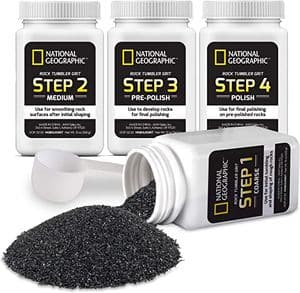
The National Geographic Rock Tumbler Grit is perfect for polishing rocks, gems, glass, and more. This grit refill kit has enough high-quality silicon carbide grit to put a dazzling polish on up to 20 lbs. of rocks. The four-stage rock tumbling grit is easy to use and compatible with all rock tumblers.
I was so excited when I got this kit in the mail. I had wanted to get into rock tumbling for a while, and this kit seemed the perfect way to get started.
I set a timer and went to bed. I woke up early the following day and rushed to the tumbler to check on my rocks. They were beautiful! The colors had popped, and they were so shiny!
I was so excited that I had accomplished something with my kids, and we could now polish these rocks until they were perfect. We would have beautiful gems to show off at our club’s next meeting. Thank you, National Geographic, for such a great product!
Pros:
- Great for polishing rocks, gems, glass, and more
- Comes with enough high-quality silicon carbide grit to polish up to 20 lbs. of rocks
- Easy to use
- Compatible with all rock tumblers
Cons:
- The final polish stage is not always perfect
Best Kit – NATIONAL GEOGRAPHIC Rock Tumbler Media

National Geographic Rock Tumbler Media is perfect for the rock polishing enthusiast. This kit comes with high-quality silicon carbide grit that will polish 8-10 lbs of rocks. The ceramic pellets and GemFoam media also help to improve your results, giving your tumbled stones a dazzling shine. With this set, you can work with any rock tumbler and get great results every time.
I was excited to try this grit I had heard so much about. It was supposed to make the process of polishing rocks so much easier. But I quickly found out that it didn’t work very well. The problem was that the grit level wasn’t consistent, so it was hard to know if I was using the right amount or not. And even if I did use the right amount, it still didn’t give me a perfect shine.
However, the gem foam is terrific for the result. So, overall, I would say this is a good kit for someone who wants to polish rocks and does not want to do the research and experiment with other products. All my mates that have this kit are happy with the results.
Pros:
- The kit contains high-quality silicon carbide grit.
- The ceramic pellets and GemFoam media help to improve your results.
- This set is perfect for the rock polishing enthusiast.
Cons:
- The grit level isn’t consistent.
- It can be hard to get a perfect shine with this kit.
Best After Tumbling – NATIONAL GEOGRAPHIC Rock Tumbling Media – GemFoam
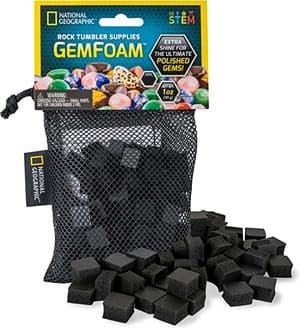
This unique new rock polishing media is safe to use with any durable tumbler and comes with a convenient reusable bag made of mesh for easy storage. GemFoam is reusable for up to 6 rock polishing cycles and helps give unprecedented shine to tumbled rocks. Use GemFoam with the National Geographic line of tumblers and rock tumbling supplies for best results. Satisfaction guaranteed – the National Geographic STEM series provides high-quality products that are a lot of fun!
If you were using National Geographic grit, apply Rock Polisher Foam after step four. I’m currently testing another brand’s step 4 compared to the foam to see if it performs better or similar.
The harder the rock, the brighter they gleam. For example, I’m currently tumbling a somewhat softer serpentinite with a hardness of four or five. It isn’t getting quite as bright, but I believe it’s still superior to before; therefore, I’m letting it tumble for a more extended period. So, if the mineral is six or above on the Mohs scale of hardness, it will shine brighter.
The conclusion I’ve come to is that these foam pebbles only work for rougher rocks that are somewhat smooth, to begin with.
Some rocks will not shine as brightly as others. The foam still gets a five-star rating for what it did to the chert, even if it didn’t work well on some rocks. I saw no improvements after only three days in the foam, so five days wouldn’t hurt.
Pros:
- Reusable for up to six cycles
- Helps give shine to tumbled rocks
- Safe to use with any durable tumbler
- Convenient reusable bag made of mesh for easy storage
Cons:
- Soft rock will remain dull
- Can not be used on unpolished rocks
- The result is unpredictable
Getting Started with Rock Tumbling
If you’re new to rock tumbling, the process can seem a bit intimidating at first. But with the right supplies and some patience, anyone can transform rough rocks into beautiful polished stones! Here’s what you need to get started tumbling:
Rock Tumbler
Obviously the first thing you’ll need is a rock tumbler. Rotary tumblers are the most common for beginners and can polish small to medium sized rocks. Vibratory tumblers work faster but are best for polishing jewelry or small stones. Consider capacity, speed settings, and quality when choosing a tumbler.
Rock Tumbler Grit
Rock polishing grit comes in four types ranging from coarse rock tumbler grit to fine grit. Start with coarse grit to smooth and shape your rocks. Progressively move to finer grits to polish them to a glossy finish. You’ll need about 1 tablespoon of first rock tumbling grit for each pound of rocks.
- Coarse grit – 60/90 silicone carbide
- Medium grit – 120/220 silicone carbide
- Fine grit – 500 aluminum oxide
- Polish – tin oxide or ceramic
Plastic Pellets
Plastic pellets cushion rocks to prevent scratches and cracks. They also let the slurry that your tumbler creates flow freely. Use 2 tablespoons per pound of rocks.
With these basic supplies, you’re ready to jump into the first stage of rock tumbling! It takes time and patience, but turning rough rocks into polished gems is incredibly rewarding. Let the tumbling begin!
A Step-by-Step Guide to the Rock Tumbling Process
The rock tumbling process is a fascinating and rewarding hobby that allows you to turn raw, rough rocks into stunning, polished gems. The tumbling process requires patience and understanding of the various stages of grit involved in this transformation. For the first rock you choose, the journey from a dull stone to a dazzling gem may seem daunting, but I promise you’ll find it gratifying and fun. This process works with any rock tumbler, be it a rotary tumbler or a vibratory tumbler.
Let’s dive right into your rock tumbling experience!
- Selecting Your Rocks: The first step is choosing the right rocks. Not every rock will produce a shiny, polished stone. Try to choose rocks with similar hardness levels to ensure an even finish. Also, consider the size of your rock tumbler when selecting your rocks. They should all fit comfortably within the tumbler barrel with enough room for the grit and polish to circulate.
- Initial Shaping (60-90 grit): In the first stage of the tumbling process, also known as the rough grind, you will use a coarse silicon carbide grit typically around 60-90 grit size. This first grit stage helps to shape the rock by knocking off the rough edges and smoothing out the surface. Use about two tablespoons of grit for every pound of rock. After a week in the rotary rock tumbler, your rocks will have a smooth, rounded appearance.
- Medium Grinding (150-220 grit): The second stage, medium grind or sanding, uses a slightly finer grit, typically 150-220 size grit. This grit stage removes the scratches and rough patches left by the coarse grit. The result is a smoother rock ready for the pre-polishing phase.
- Pre-Polishing (500 grit): The third phase of the tumbling process is where things start to get exciting. Using 500 grit silicon carbide, the pre-polish step removes any remaining scratches and prepares the rocks for the final polish. You will see your rocks begin to shine after this stage!
- Polishing (Polish step): The last stage of the tumbling process is the polish stage, where we use a rock polish or a four-step grit like aluminum oxide. The polish step gives your stones that dazzling shine that makes them look like they were store-bought!
Remember, the key to successful rock tumbling is patience and consistency. Depending on the type and size of your rocks, the whole process can take several weeks.
| Rock Tumbling Stage | Grit Size | Grit Material | Time |
|---|---|---|---|
| Initial Shaping | 60-90 | Silicon Carbide | 1 Week |
| Medium Grinding | 150-220 | Silicon Carbide | 1 Week |
| Pre-Polishing | 500 | Silicon Carbide | 1 Week |
| Polishing | Variable | Polish Material (Aluminium Oxide) | 1 Week |
The Best Rock Tumbling Grit to Use
When considering the best rock tumbling grit to use, the Polly Plastics Rock Tumbler Media and the Rock Tumbler Grit Refill Kit are excellent options. Both these products offer high-quality grit that will leave your rocks shining brightly. The Polly Plastics Rock Tumbler Media contains a comprehensive grit set and poly plastic that is compatible with any rock tumbler.
One vital factor to remember is that silicon carbide is the preferred grit for rock tumbling. The preferred grit for rock tumbling is silicon carbide because of its hardness and ability to wear down and smooth out the rocks effectively.
| Product | Grit Material | Grit Sizes Included | Compatible With |
|---|---|---|---|
| Polly Plastics Rock Tumbler Media | Silicon Carbide, Poly Plastic | 60-90, 150-220, 500, Polish | Any Rock Tumbler |
| Rock Tumbler Grit Refill Kit | Silicon Carbide | 60-90, 150-220, 500, Polish | Any Rock Tumbler |
Now that you have a detailed guide to rock tumbling, you’re equipped with all you need to turn any ordinary stone into a dazzling gem. So, gather your rocks, fire up that tumbler, and let’s get tumbling!
What is grit, and why do you need it for rock tumbling?
Grit is a term used to describe the abrasive particles used in rock tumbling. These particles polish the rocks as they fall, and they come in various sizes and types. The size of the grit particles will determine how long it takes to polish your stones, and the type of grit will determine the final results. There are three main types of grit:
- Silicone carbide. This is the most common type of grit used for rock tumbling. It is affordable and works well on a variety of rocks.
- Aluminum oxide. This type of grit is a bit more expensive, but it works well on harder rocks.
- Ceramic. This is the most costly type of grit but is also the best for polishing rocks.
What Is Rock Tumbling Grit Made Of?
Silicone carbide grit
Rock tumbling grit is made of silicon carbide, an artificial material. It is tough and has a Mohs hardness of nine. This means that it can scratch any rock that has a lower hardness rating.
Aluminum oxide
Aluminum oxide grit is also artificial. It has a Mohs hardness of nine and is slightly harder than silicon carbide. However, it is not as tough and can break if it hits a rock with a higher hardness rating.
Ceramic
Ceramic grit is made from natural materials, such as quartz, feldspar, and clay. It is very tough and has a Mohs hardness of eight. This means that it will not scratch rocks with a higher hardness rating.
Is Rock Tumbler Grit Toxic?
No, rock tumbler grit is not toxic. However, it is a good idea to wear a dust mask when using it, as inhaling the particles can harm your lungs.
Can I reuse grit?
Yes, you can reuse grit. However, it will eventually break down and become less effective. When this happens, you will need to replace it with new grit.
Levels of Rock Tumbler Grit
There are four different levels of rock tumbler grit:
- Coarse. Coarse grit is used to remove rough edges from rocks. It is the largest type of grit and is usually silicon carbide.
- Medium. Medium grit is used to smooth the surface of stones. It is smaller than coarse grit and is generally made of aluminum oxide.
- Fine. Fine grit is used to polish the surface of rocks. It is the smallest type of grit and is usually made of ceramic.
- Ultra-fine. Ultra-fine grit is used to give rocks a high shine. It is smaller than fine grit and usually made of ceramic.
What grit sizes and polish do I need?
The type of grit you need will depend on the kind of rocks you are tumbling, as well as your personal preferences. For example, if you are tumbling soft rocks, such as calcite or fluorite, you will need a coarser grit to achieve results. On the other hand, if you are tumbling hard rocks, such as quartz or agate, you will need a finer grit size to achieve results.
As for polish, you will need to choose a type compatible with the grit size you are using. For example, if you are using coarse grit, you will need to use a coarser polish. If you are using fine grit, you will need to use a finer polish.
How much grit to use?
The amount of grit you need will depend on the size of your tumbler and the type of rocks you are tumbling. A good rule of thumb is to use one pound of grit per gallon of capacity. So, for example, if you have a three-gallon tumbler, you should use three pounds of grit.
What to look for when buying grit
When buying grit, you should ensure that you get the right type and size for your needs. You should also check the expiration date on the package, as some types of grit can expire. Finally, you should make sure that the price is reasonable.
How can I safely dispose of used grit (or slurry)?
You can dispose of used grit (or slurry) by putting it in a plastic bag and placing it in the trash. However, you should not pour it down the drain, as this can clog your pipes.
Tips for getting the best results from your rock tumbling hobby!
Here are a few tips to help you get the best results from your hobby:
- Start with coarse grit and work your way up to fine grit. Do not skip any steps, as this will result in poor results.
- Be sure to use the right type and size of grit for your needs.
- Check the expiration date on your grit before using it.
- Use a dust mask when tumbling, as inhaling the particles can harm your lungs.
- When you are finished tumbling, please dispose of the used grit (or slurry) by putting it in a plastic bag and placing it in the trash. Do not pour it down the drain!
Rock Tumbling Grit Alternatives
If you can’t find rock tumbling grit, there are a few alternatives you can use:
- Walnut shells. Walnut shells are an excellent alternative to medium grit. You can find them at your local pet store.
- Corn cob filler. Corn cob filler is an excellent alternative to fine grit. You can find it at your local craft store.
- Baking soda. Baking soda is an excellent alternative to ultra-fine grit. You can find it at your local grocery store.
FAQ
Can I Use Sand Instead of Rock Tumbler Grit?
No, sand is not a good substitute for rock tumbler grit. Sand is too soft and will not be effective in tumbling rocks.
Can I Use Beach Sand?
No, beach sand is not a good substitute for rock tumbler grit. Beach sand contains salt, which can rust the parts of your tumbler.
Why Don't You Use Extra Coarse for Extra Fast Grinding?
Extra coarse grit is not recommended for tumbling because it is too abrasive and can damage your rocks.
Would I Get a Better Polish With a 1000 Grit Step?
No, you would not get a better polish with a 1000 grit step. The difference in polishing between fine and ultra-fine is minimal.
What's the Deal With Pre-Polishes?
Pre-polishes are unnecessary and can damage your rocks if misused.
My Grit Is Labeled 500F. What Does the F Mean?
The F stands for 'fines'. This means that the grit has been screened to remove any large particles.
Do I Need to Wear a Mask When Tumbling?
Yes, it is vital to wear a dust mask when tumbling, as inhaling the particles can harm your lungs.
What Else Can I Use Rock Tumbler Grit For?
In addition to tumbling rocks, you can also use rock tumbler grit to polish metal. Add a small amount of grit to a buffing wheel and buff the metal until it is shiny.
What is the best rock tumbler media?
There are a few things to consider when choosing the best rock tumbler media. The most important factor is the size of the media. The smaller the media, the faster it will polish rocks. However, if the media is too small, it can become lodged in tight spaces and be difficult to remove. Larger media take longer to polish rocks but are less likely to get stuck. Other factors that can influence the choice of media include its hardness and abrasiveness. Media with a higher hardness will wear down rocks more quickly, whilemedia with a higher abrasiveness will produce a smoother finish on rocks.
What is the best pre-polish grit for rock tumbling?
The best pre-polish grit for rock tumbling will vary depending on the type of rocks you are tumbling. For example, if you are tumbling softer rocks like calcite or dolomite, a grit between 220 and 320 would be best. If you are tumbing harder rocks like quartz or agate, a grit between 100 and 220 would be best. Ultimately, it is best to experiment with different grits to find the one that produces the desired results.
What are the different types of grit for rock tumbling?
There are three main types of grit for rock tumbling: coarse, medium, and fine. Coarse grit is used to shape and smooth the rough edges of the rock, medium grit is used to further smooth and refine the surface, and fine grit is used to polish the rock to a high shine.
How do I choose the right grit for my rock tumbling project?
The grit you choose will depend on the type of rock you are tumbling, and the level of polish you want to achieve. For most types of rocks, a grit progression of coarse, medium, and fine grit is recommended, starting with the coarsest grit and progressing to the finest grit. It's also important to note that some rocks are harder than others and will require different grit progression and longer tumbling time.
How much grit should I use in my rock tumbler?
The amount of grit to use in your rock tumbler will depend on the size of the barrel and the amount of rocks you are tumbling. As a general rule, you should use enough grit to completely cover the rocks in the barrel, but not so much that the rocks are tightly packed or are not able to move freely.
Final Words
Rock tumbling is a fun and easy way to polish rocks and metal. To get the best results, it is crucial to use the right type and size of grit. You should also ensure that the grit is fresh and has not expired. When you are finished tumbling, be sure to dispose of the used grit properly.
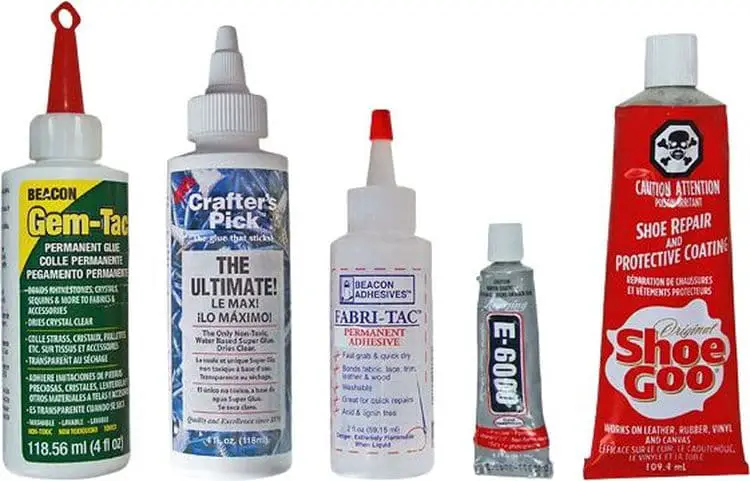
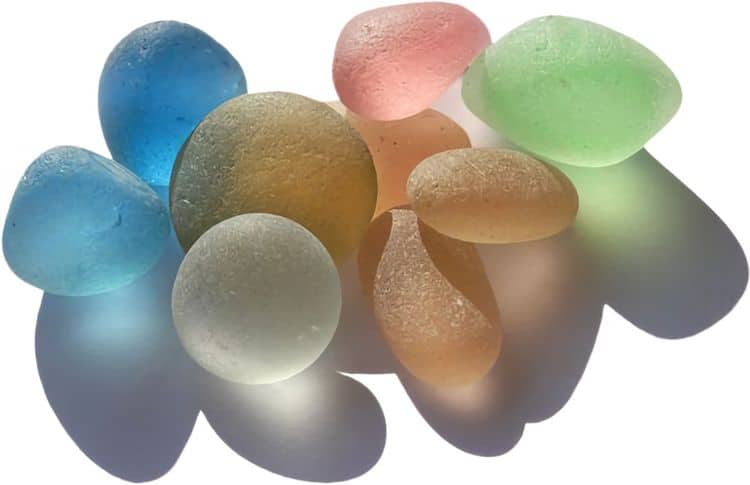
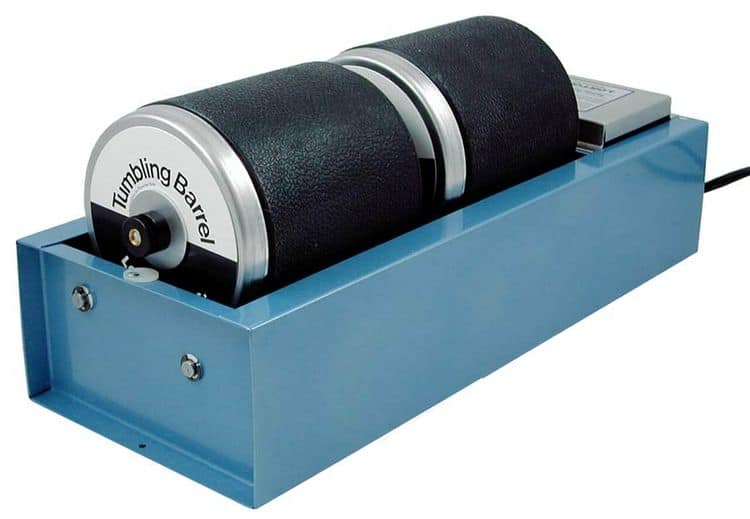

Leave a Reply